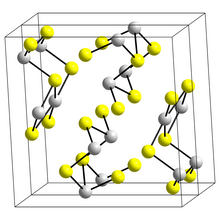Antimony trisulfide (Sb2S3) is found in nature as the crystalline mineral stibnite and the amorphous red mineral (actually a mineraloid)[3] metastibnite.[4] It is manufactured for use in safety matches, military ammunition, explosives and fireworks. It also is used in the production of ruby-colored glass and in plastics as a flame retardant.[5] Historically the stibnite form was used as a grey pigment in paintings produced in the 16th century.[6] In 1817, the dye and fabric chemist, John Mercer discovered the non-stoichiometric compound Antimony Orange (approximate formula Sb2S3·Sb2O3), the first good orange pigment available for cotton fabric printing.[7]

| |

| |
| Names | |
|---|---|
| IUPAC names
Antimony(III) sulfide | |
Other names
| |
| Identifiers | |
3D model (JSmol) |
|
| ChemSpider | |
| ECHA InfoCard | 100.014.285 |
PubChem CID |
|
| UNII | |
CompTox Dashboard (EPA) |
|
| |
| |
| Properties | |
| Sb2S3 | |
| Molar mass | 339.70 g·mol−1 |
| Appearance | Grey or black orthorhombic crystals (stibnite) |
| Density | 4.562g cm−3 (stibnite)[1] |
| Melting point | 550 °C (1,022 °F; 823 K) (stibnite)[1] |
| Boiling point | 1,150 °C (2,100 °F; 1,420 K) |
| 0.00017 g/(100 mL) (18 °C) | |
| −86.0·10−6cm3/mol | |
Refractive index (nD) |
4.046 |
| Thermochemistry | |
Heat capacity (C) |
123.32 J/(mol·K) |
Std enthalpy of |
−157.8 kJ/mol |
| Hazards | |
| NFPA 704 (fire diamond) | |
| Lethal dose or concentration (LD, LC): | |
LD50 (median dose) |
> 2000 mg/kg (rat, oral) |
| NIOSH (US health exposure limits): | |
PEL (Permissible) |
TWA 0.5 mg/m3 (as Sb)[2] |
REL (Recommended) |
TWA 0.5 mg/m3 (as Sb)[2] |
| Related compounds | |
Other anions |
|
Other cations |
Arsenic trisulfide Bismuth(III) sulfide |
Related compounds |
Antimony pentasulfide |
Except where otherwise noted, data are given for materials in their standard state (at 25 °C [77 °F], 100 kPa).
| |
Antimony trisulfide was also used as the image sensitive photoconductorinvidicon camera tubes. It is a semiconductor with a direct band gap of 1.8–2.5 eV.[citation needed] With suitable doping, p and n type materials can be produced.[8]
Sb2S3 can be prepared from the elements at temperature 500–900 °C:[5]
Sb2S3 is precipitated when H2S is passed through an acidified solution of Sb(III).[9] This reaction has been used as a gravimetric method for determining antimony, bubbling H2S through a solution of Sb(III) compound in hot HCl deposits an orange form of Sb2S3 which turns black under the reaction conditions.[10]
Sb2S3 is readily oxidised, reacting vigorously with oxidising agents.[5] It burns in air with a blue flame. It reacts with incandescence with cadmium, magnesium and zinc chlorates. Mixtures of Sb2S3 and chlorates may explode.[11]
In the extraction of antimony from antimony ores the alkaline sulfide process is employed where Sb2S3 reacts to form thioantimonate(III) salts (also called thioantimonite):[12]
A number of salts containing different thioantimonate(III) ions can be prepared from Sb2S3. These include:[13]
Schlippe's salt, Na3SbS4·9H2O, a thioantimonate(V) salt is formed when Sb2S3 is boiled with sulfur and sodium hydroxide. The reaction can be represented as:[9]
The structure of the black needle-like form of Sb2S3, stibnite, consists of linked ribbons in which antimony atoms are in two different coordination environments, trigonal pyramidal and square pyramidal.[9] Similar ribbons occur in Bi2S3 and Sb2Se3.[14] The red form, metastibnite, is amorphous. Recent work suggests that there are a number of closely related temperature dependent structures of stibnite which have been termed stibnite (I) the high temperature form, identified previously, stibnite (II) and stibnite (III).[15] Other paper shows that the actual coordination polyhedra of antimony are in fact SbS7, with (3+4) coordination at the M1 site and (5+2) at the M2 site.[clarification needed] These coordinations consider the presence of secondary bonds. Some of the secondary bonds impart cohesion and are connected with packing.[16]